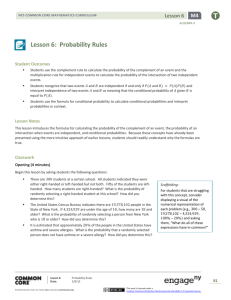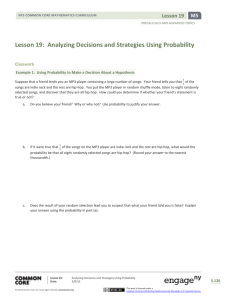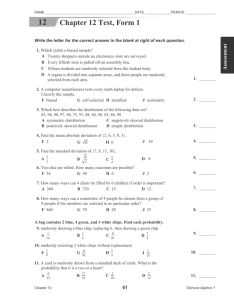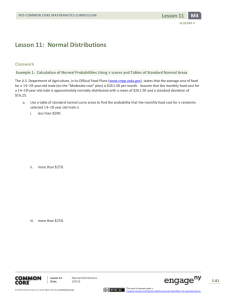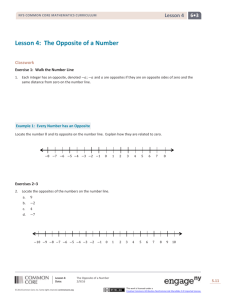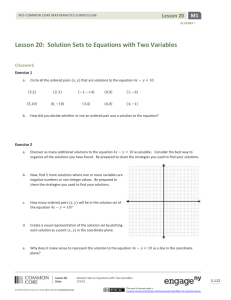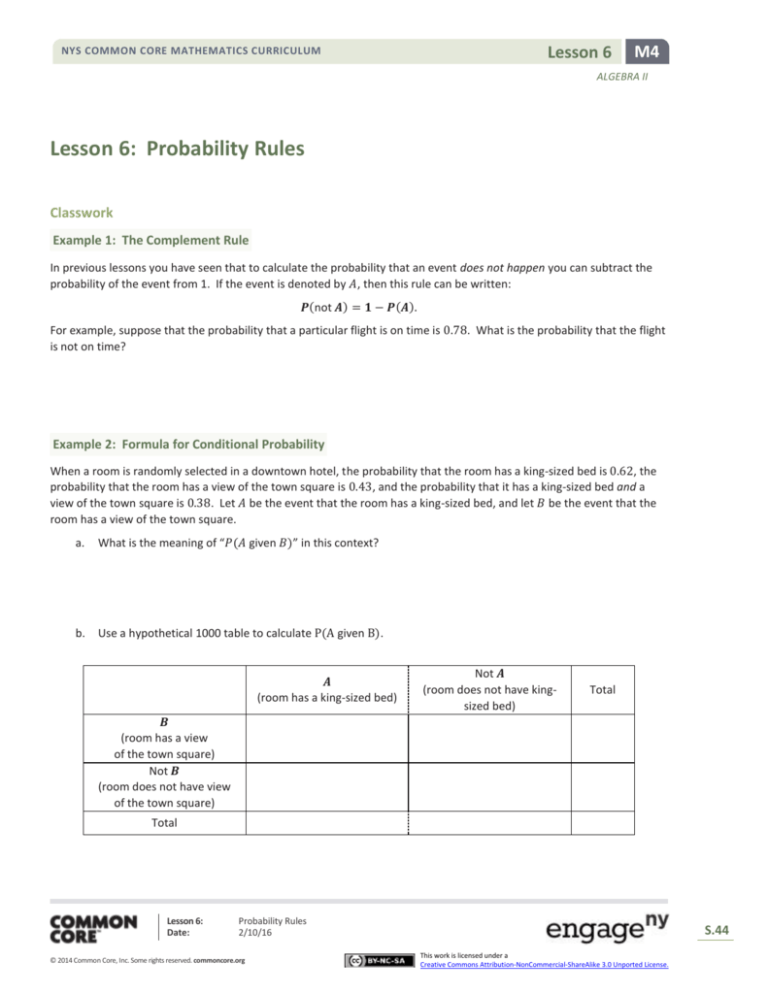
NYS COMMON CORE MATHEMATICS CURRICULUM
Lesson 6
M4
ALGEBRA II
Lesson 6: Probability Rules
Classwork
Example 1: The Complement Rule
In previous lessons you have seen that to calculate the probability that an event does not happen you can subtract the
probability of the event from 1. If the event is denoted by 𝐴, then this rule can be written:
𝑷(not 𝑨) = 𝟏 − 𝑷(𝑨).
For example, suppose that the probability that a particular flight is on time is 0.78. What is the probability that the flight
is not on time?
Example 2: Formula for Conditional Probability
When a room is randomly selected in a downtown hotel, the probability that the room has a king-sized bed is 0.62, the
probability that the room has a view of the town square is 0.43, and the probability that it has a king-sized bed and a
view of the town square is 0.38. Let 𝐴 be the event that the room has a king-sized bed, and let 𝐵 be the event that the
room has a view of the town square.
a.
What is the meaning of “𝑃(𝐴 given 𝐵)” in this context?
b.
Use a hypothetical 1000 table to calculate P(A given B).
𝑨
(room has a king-sized bed)
Not 𝑨
(room does not have kingsized bed)
Total
𝑩
(room has a view
of the town square)
Not 𝑩
(room does not have view
of the town square)
Total
Lesson 6:
Date:
Probability Rules
2/10/16
© 2014 Common Core, Inc. Some rights reserved. commoncore.org
S.44
This work is licensed under a
Creative Commons Attribution-NonCommercial-ShareAlike 3.0 Unported License.
Lesson 6
NYS COMMON CORE MATHEMATICS CURRICULUM
M4
ALGEBRA II
c.
There is also a formula for calculating a conditional probability. The formula for conditional probability is
𝑷(𝑨 given 𝑩) =
𝑷(𝑨 and 𝑩)
.
𝑷(𝑩)
Use this formula to calculate 𝑃(𝐴 given 𝐵), where the events 𝐴 and 𝐵 are as defined in this example.
d.
How does the probability you calculated using the formula compare to the probability you calculated using the
hypothetical 1000 table?
Exercise 1
A credit card company states that 42% of its customers are classified as long-term cardholders, 35%
pay their bills
in full each month, and 23% are long-term cardholders who also pay their bills in full each month. Let the event that a
randomly selected customer is a long-term cardholder be 𝐿, and the event that a randomly selected customer pays his or
her bill in full each month be 𝐹.
a.
What are the values of 𝑃(𝐿), 𝑃(𝐹), and 𝑃(𝐿 and 𝐹)?
b.
Draw a Venn diagram, and label it with the probabilities from part (a).
c.
Use the conditional probability formula to calculate 𝑃(𝐿 given 𝐹). (Round your answer to the nearest
thousandth.)
Lesson 6:
Date:
Probability Rules
2/10/16
© 2014 Common Core, Inc. Some rights reserved. commoncore.org
S.45
This work is licensed under a
Creative Commons Attribution-NonCommercial-ShareAlike 3.0 Unported License.
Lesson 6
NYS COMMON CORE MATHEMATICS CURRICULUM
M4
ALGEBRA II
d.
Use the conditional probability formula to calculate 𝑃(𝐹 given 𝐿). (Round your answer to the nearest
thousandth.)
e.
Which is greater, 𝑃(𝐹 given 𝐿) or 𝑃(𝐹)? Explain why this is relevant.
f.
Remember that two events A and B are said to be independent if 𝑃(𝐴 given 𝐵) = 𝑃(𝐴). Are the events 𝐹 and
𝐿 independent? Explain.
Example 3: Using the Multiplication Rule for Independent Events
A number cube has faces numbered 1 through 6, and a coin has two sides, heads and tails.
The number cube will be rolled and the coin will be flipped. Find the probability that the cube shows a 4 and the coin
lands heads. Because the events are independent, we can use the multiplication rules we just learned.
If you toss the coin five times, what is the probability you will see a head on all five tosses?
If you tossed the coin five times and got five heads, would you think that this coin is a fair coin? Why or why not?
If you roll the number cube three times, what is the probability that it will show 4 on all three throws?
Lesson 6:
Date:
Probability Rules
2/10/16
© 2014 Common Core, Inc. Some rights reserved. commoncore.org
S.46
This work is licensed under a
Creative Commons Attribution-NonCommercial-ShareAlike 3.0 Unported License.
NYS COMMON CORE MATHEMATICS CURRICULUM
Lesson 6
M4
ALGEBRA II
If you rolled the number cube three times and got a 4 on all three rolls, would you think that this number cube is fair?
Why or why not?
Suppose that the credit card company introduced in Exercise 1 states that when a customer is selected at random, the
probability that the customer pays his or her bill in full each month is 0.35, the probability that the customer makes
regular online purchases is 0.83, and these two events are independent. What is the probability that a randomly
selected customer pays his or her bill in full each month and makes regular online purchases?
Exercise 2
A spinner has a pointer, and when the pointer is spun, the probability that it stops in the red section of the spinner is
0.25.
a.
If the pointer is spun twice, what is the probability that it will stop in the red section on both occasions?
b.
If the pointer is spun four times, what is the probability that it will stop in the red section on all four occasions?
(Round your answer to the nearest thousandth.)
c.
If the pointer is spun five times, what is the probability that it never stops on red? (Round your answer to the
nearest thousandth.)
Lesson 6:
Date:
Probability Rules
2/10/16
© 2014 Common Core, Inc. Some rights reserved. commoncore.org
S.47
This work is licensed under a
Creative Commons Attribution-NonCommercial-ShareAlike 3.0 Unported License.
Lesson 6
NYS COMMON CORE MATHEMATICS CURRICULUM
M4
ALGEBRA II
Lesson Summary
For any event 𝐴, 𝑃(not 𝐴) = 1 − 𝑃(𝐴).
For any two events 𝐴 and 𝐵, 𝑃(𝐴 given 𝐵) =
𝑃(𝐴 and 𝐵)
.
𝑃(𝐴)
Events 𝐴 and 𝐵 are independent if and only if 𝑃(𝐴 and 𝐵) = 𝑃(𝐴)𝑃(𝐵).
Problem Set
1.
When an avocado is selected at random from those delivered to a food store, the probability that it is ripe is 0.12,
the probability that it is bruised is 0.054, and the probability that it is ripe and bruised is 0.019.
a.
2.
Rounding your answers to the nearest thousandth where necessary, find the probability that an avocado
randomly selected from those delivered to the store is
i.
not bruised.
ii.
ripe given that it is bruised.
iii.
bruised given that it is ripe.
b.
Which is larger, the probability that a randomly selected avocado is bruised given that it is ripe or the
probability that a randomly selected avocado is bruised? Explain in words what this tells you.
c.
Are the events ripe and bruised independent? Explain.
Return to the probability information given in Problem 1. Complete the hypothetical 1000 table given below, and
use it to find the probability that a randomly selected avocado is bruised given that it is not ripe. (Round your
answer to the nearest thousandth.)
Ripe
Not Ripe
Total
Bruised
Not bruised
Total
3.
According to the website www.census.gov, based on the US population in 2010, the probability that a randomly
selected male is 65 or older is 0.114, and the probability that a randomly selected female is 65 or older is 0.146. (In
the questions that follow, round your answers to the nearest thousandth.)
a.
If a male is selected at random and a female is selected at random, what is the probability that both people
selected are 65 or older? (Hint: Use the multiplication rule for independent events.)
b.
If two males are selected at random, what is the probability that both of them are 65 or older?
c.
If two females are selected at random, what is the probability that neither of them is 65 or older?
Lesson 6:
Date:
Probability Rules
2/10/16
© 2014 Common Core, Inc. Some rights reserved. commoncore.org
S.48
This work is licensed under a
Creative Commons Attribution-NonCommercial-ShareAlike 3.0 Unported License.
Lesson 6
NYS COMMON CORE MATHEMATICS CURRICULUM
M4
ALGEBRA II
4.
5.
6.
In a large community, 72% of the people are adults, 78% of the people have traveled outside the state, and 11%
are adults who have not traveled outside the state.
a.
Using a Venn diagram or a hypothetical 1000 table, calculate the probability that a randomly selected person
from the community is an adult and has traveled outside the state.
b.
Use the multiplication rule for independent events to decide whether the events is an adult and has traveled
outside the state are independent.
In a particular calendar year, 10% of the registered voters in a small city are called for jury duty. In this city, people
are selected for jury duty at random from all registered voters in the city, and the same individual cannot be called
more than once during the calendar year.
a.
What is the probability that a registered voter is not called for jury duty during a particular year?
b.
What is the probability that a registered voter is called for jury duty two years in a row?
A survey of registered voters in a city in New York was carried out to assess support for a new school tax. 51% of
the respondents supported the school tax. Of those with school-age children, 56% supported the school tax, while
only 45% of those who did not have school-age children supported the school tax.
a.
If a person who responded to this survey is selected at random, what is the probability that
i.
the person selected supports the school tax?
ii.
the person supports the school tax given that he or she does not have school-age children?
b.
Are the two events has school-age children and supports the school tax independent? Explain how you know
this.
c.
Suppose that 35% of those responding to the survey were over the age of 65 and that 10% of those
responding to the survey were both over age 65 and supported the school tax. What is the probability that a
randomly selected person who responded to this survey supported the school tax given that he or she was
over age 65?
Lesson 6:
Date:
Probability Rules
2/10/16
© 2014 Common Core, Inc. Some rights reserved. commoncore.org
S.49
This work is licensed under a
Creative Commons Attribution-NonCommercial-ShareAlike 3.0 Unported License.

